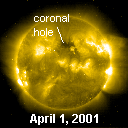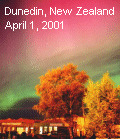|   SPACE WEATHER SPACE WEATHER
Current
Conditions
Solar Wind
velocity: 676.1 km/s
density:0.5 protons/cm3
explanation | more data
Updated: Today at 2047 UT
X-ray Solar Flares
6-hr max: M3 1950 UT Apr01
24-hr: M5 1215 UT Apr01
explanation | more data
Updated: Today at 2050 UT
Daily Sun: 01 Apr '01 
The large sunspot group 9393 exhibits a delta magnetic field that could harbors energy for powerful X-class solar flares.
Sunspot Number: 326
More about sunspots
Updated: 31 Apr 2001
Radio Meteor Rate
24 hr max: 30 per hr
Listen to the Meteor Radar!
Updated: 01 Apr 2001 Interplanetary Mag. Field
Btotal: 6.5 nT
Bz: 1.7 nT south
explanation | more data
Updated: Today at 2048 UT Coronal Holes:

This small coronal hole is spewing a high-speed solar wind stream that Earth might encounter in a few days. Image credit: SOHO Extreme UV Telescope.
More about coronal holes
 SPACE WEATHER SPACE WEATHER
NOAA
Forecasts
Solar Flares: Probabilities for a medium-sized (M-class) or a major (X-class) solar flare during the next 24/48 hours are tabulated below.
Updated at 2001 Mar 31 2200 UT
| FLARE | 24 hr | 48 hr | | CLASS M | 80 % | 80 % | | CLASS X | 35 % | 35 % |
Geomagnetic Storms: Probabilities for significant disturbances in Earth's magnetic field are given for three activity levels: active, minor storm, severe storm
Updated at 2001 Mar 31 2200 UT Mid-latitudes | 24 hr | 48 hr | | ACTIVE | 20 % | 50 % | | MINOR | 25 % | 10 % | | SEVERE | 35 % | 15 % |
High latitudes | 24 hr | 48 hr | | ACTIVE | 27 % | 27 % | | MINOR | 30 % | 30 % | | SEVERE | 25 % | 15 % |

Web server provided by
VPS Hosting
| What's Up in Space -- 1 Apr 2001
Subscribe to Space Weather News!  AURORA WATCH: After persisting for more than 24 hours, this weekend's severe geomagnetic storm has subsided. The storm began at 0100 UT on March 31st (8 p.m. EST on March 30th) when a coronal mass ejection (CME) struck Earth's magnetosphere. Sky watchers as far south as Texas, southern California and Mexico saw bright Northern Lights after the impact. Click to view our growing gallery of aurora photos. AURORA WATCH: After persisting for more than 24 hours, this weekend's severe geomagnetic storm has subsided. The storm began at 0100 UT on March 31st (8 p.m. EST on March 30th) when a coronal mass ejection (CME) struck Earth's magnetosphere. Sky watchers as far south as Texas, southern California and Mexico saw bright Northern Lights after the impact. Click to view our growing gallery of aurora photos.
A second CME struck at ~2200 UT on March 31th. Instead of firing up the storm, however, the impact quenched it. When the CME passed Earth the interplanetary magnetic field surrounding our planet suddenly turned north -- an unfavorable direction for auroras. The speed of the solar wind rushing past our planet remains very high. Gusts could re-energize the storm at any time and produce isolated displays of intense auroras. If you live above ~55 deg. geomagnetic latitude, please remain alert for Northern Lights. The best time to look is near local midnight. 
Above: The Kp index, a measure of global geomagnetic activity, soared to storm levels on March 31st. The two CMEs that hit Earth on March 31st were hurled into space by explosions near the giant sunspot 9393 on Wednesday and Thursday (March 28th and 29th). It takes two to three days for such expanding clouds to cross the divide between the Sun and our planet -- hence the double impacts early and late Saturday.  GIANT SUNSPOT: Sunspot 9393 covers an area of the solar disk equivalent to the combined surface area of 13 planet Earths. That makes it the largest sunspot of the current solar cycle. You can see this huge spot for yourself, but be careful: Looking directly at the Sun can cause permanent eye damage. Click to learn more about safe solar observing. GIANT SUNSPOT: Sunspot 9393 covers an area of the solar disk equivalent to the combined surface area of 13 planet Earths. That makes it the largest sunspot of the current solar cycle. You can see this huge spot for yourself, but be careful: Looking directly at the Sun can cause permanent eye damage. Click to learn more about safe solar observing.
WEB LINKS: NOAA FORECAST | GLOSSARY | SPACE WEATHER TUTORIAL | LESSON PLANS | BECOME A SUBSCRIBER | 
Potentially Hazardous Asteroids (PHAs) are space rocks larger than approximately 100m that can come closer to Earth than 0.05 AU. None of the known PHAs are on a collision course with our planet, although astronomers are finding new ones all the time. [more]
On 1 Apr 2001 there were 298 known Potentially
Hazardous Asteroids ASTEROIDS GALORE: March has been a good month for asteroid hunters. Since March 21st astronomers have spotted six Earth-approaching space rocks (click to view 3D orbits): 2001 FE90, 2001 FB90, 2001 FD58, 2001 FC58, 2001 FA58 and 2001 FO32. There is no danger of a collision with any of these asteroids. Earth-asteroid encounters (Mar 1 - Apr 30) 
- TOTAL LUNAR ECLIPSE: On Jan. 9, 2001, the full Moon glided through Earth's copper-colored shadow. [gallery]
- CHRISTMAS ECLIPSE: Sky watchers across North America enjoyed a partial solar eclipse on Christmas Day 2000 [gallery]
- LEONIDS 2000: Observers around the globe enjoyed three predicted episodes of shooting stars. [gallery]
 Feb. 21, 2001: Nature's Tiniest Space Junk -- Using an experimental radar at the Marshall Space Flight Center, scientists are monitoring tiny but hazardous meteoroids that swarm around our planet. Feb. 15, 2001: The Sun Does a Flip -- NASA scientists who monitor the Sun say our star's enormous magnetic field is reversing -- a sure sign that solar maximum is here. Jan. 25, 2001: Earth's Invisible Magnetic Tail -- NASA's IMAGE spacecraft, the first to enjoy a global view of the magnetosphere, spotted a curious plasma tail pointing from Earth toward the Sun. Jan. 4, 2001: Earth at Perihelion -- On January 4, 2001, our planet made its annual closest approach to the Sun. Dec. 29, 2000: Millennium Meteors -- North Americans will have a front-row seat for a brief but powerful meteor shower on January 3, 2001. Dec. 28, 2000: Galileo Looks for Auroras on Ganymede -- NASA's durable Galileo spacecraft flew above the solar system's largest moon this morning in search of extraterrestrial "Northern Lights" Dec. 22, 2000: Watching the Angry Sun -- Solar physicists are enjoying their best-ever look at a Solar Maximum thanks to NOAA and NASA satellites. MORE SPACE WEATHER HEADLINES |

